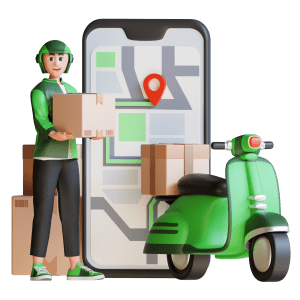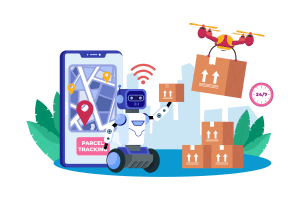In today’s fast-paced world, the ecommerce industry is constantly evolving to meet the demands of consumers who seek convenience and instant gratification. One such demand that has gained significant traction is same-day delivery. The concept of same-day delivery refers to the ability to have online purchases delivered to customers’ doorsteps within the same day of placing an order. This delivery option has revolutionized the way people shop online, offering unprecedented speed and convenience.
Canada, known for its vast landscapes and diverse population, is no exception to the growing demand for fast and reliable delivery services. With a significant increase in online shopping activities, Canadian consumers are increasingly expecting shorter delivery times and exceptional service. Whether it’s a last-minute gift, essential household items, or the latest fashion trends, the desire for same-day delivery has become an integral part of the online shopping experience in Canada.
However, the implementation of same-day delivery is not as simple as it may seem. It requires a well-established and efficient logistics infrastructure to ensure that packages are processed, shipped, and delivered seamlessly within the same day. From warehousing and inventory management to order processing and fulfillment, every step of the supply chain needs to be optimized to meet the time-sensitive demands of same-day delivery.
Efficient logistics operations play a pivotal role in the success of same-day delivery services. It involves meticulous planning, effective coordination, and leveraging technological advancements to minimize transit times and optimize delivery routes. Additionally, ensuring a seamless last-mile delivery experience, where packages reach customers’ doorsteps on time, is a critical aspect of same-day delivery logistics. To achieve this, collaborations with local couriers and leveraging innovative solutions have become essential.


Understanding Same Day Delivery in Ecommerce
In the ever-growing world of ecommerce, same-day delivery has emerged as a game-changer, revolutionizing the way online retailers connect with their customers. Same-day delivery refers to the swift transportation of products from the retailer’s warehouse or fulfillment center to the customer’s doorstep within the same day of placing an order.
The significance of same-day delivery for online retailers cannot be overstated. It provides a competitive edge by offering a level of convenience and immediacy that traditional delivery options cannot match. By meeting customers’ expectations for fast delivery, retailers can enhance customer satisfaction, improve brand loyalty, and ultimately drive repeat business.
For customers, same-day delivery offers unparalleled convenience and instant gratification. It eliminates the waiting time associated with traditional delivery options, allowing them to receive their purchases on the same day they desire them. Whether it’s a forgotten birthday gift or a last-minute necessity, same-day delivery ensures that customers can obtain products promptly, saving them from the hassle of rushing to physical stores.
Statistics and trends reflect the growing popularity and importance of same-day delivery in the ecommerce industry. According to Retail Touchpoint, 88% of consumers are willing to pay extra for same-day or faster delivery options. Furthermore, 59% of consumers have abandoned their shopping carts due to unsatisfactory delivery options.
The rise of major ecommerce players like Amazon Prime has also contributed to the increased demand for same-day delivery. Amazon, known for its Prime membership program, offers same-day delivery as a key benefit, which has set a precedent in the industry. This has prompted other retailers to follow suit in order to remain competitive.
Additionally, advancements in logistics technology have played a crucial role in enabling same-day delivery. Real-time tracking, automated order processing, and optimized route planning have streamlined the logistics process, making same-day delivery more feasible and cost-effective for businesses.
The COVID-19 pandemic has further accelerated the popularity of same-day delivery. With lockdowns and social distancing measures in place, online shopping has experienced a significant surge, and customers have come to rely on same-day delivery as a safe and convenient way to receive essential items without leaving their homes.
The Canadian Ecommerce Landscape
With a digitally connected population and a strong economy, the ecommerce industry in Canada has witnessed significant growth in recent years. Canadians have embraced online shopping as a convenient and efficient way to purchase a wide range of products and services. Let’s delve into the key aspects of the Canadian ecommerce landscape, including market overview, key players, market trends, and logistical challenges.
Market Overview:
The Canadian ecommerce market has experienced substantial expansion, fueled by factors such as increased internet penetration, changing consumer behavior, and improved logistics infrastructure. According to Statistics Canada, ecommerce sales in Canada reached a record high of CAD 305.1 billion in 2020, representing a 45.2% increase compared to the previous year.
Key Players:
Amazon: As a global ecommerce giant, Amazon holds a significant share of the Canadian market. Its marketplace platform and Prime membership program have revolutionized online shopping, offering fast and reliable delivery options, including same-day delivery.
Shopify: Based in Ottawa, Shopify has emerged as a leading ecommerce platform provider, empowering businesses of all sizes to establish their online stores. With its user-friendly interface and extensive range of features, Shopify has become a popular choice for Canadian entrepreneurs.
Walmart: A prominent retail player, Walmart has successfully established its online presence in Canada. Through its robust ecommerce platform, it offers a wide range of products, competitive pricing, and convenient delivery options.
Best Buy Canada: Known for its electronics and technology products, Best Buy Canada has adapted to the online shopping trend, providing a seamless ecommerce experience and fast delivery options.
Market Trends:
Mobile Commerce: With the proliferation of smartphones, mobile commerce (m-commerce) has witnessed remarkable growth in Canada. Consumers are increasingly using mobile devices to browse, shop, and make purchases, prompting retailers to optimize their platforms for mobile accessibility.
Cross-Border Shopping: Due to the proximity to the United States, Canadian consumers often engage in cross-border shopping, leveraging the wider product selection and competitive pricing available from American retailers. However, efforts are being made to enhance domestic offerings and retain Canadian customers within the local ecommerce ecosystem.
Sustainability and Ethical Consumerism: Canadian consumers are becoming more environmentally conscious and value-driven. They are showing a preference for eco-friendly and socially responsible products, pushing ecommerce businesses to adopt sustainable practices and promote ethical sourcing.
Logistical Challenges:
Vast Geographical Spread: Canada’s expansive geography presents a unique challenge for logistics in ecommerce. The country’s size and varying population density across regions make it challenging to provide efficient and cost-effective delivery options, particularly in remote areas.
Seasonal Variations: Canada experiences extreme weather conditions, which can impact logistics operations. Harsh winters, heavy snowfall, and storms can cause delays and disruptions in transportation and delivery, necessitating robust contingency plans.
Cross-Border Customs and Duties: For Canadian ecommerce businesses engaging in cross-border trade, navigating customs regulations and managing duties and taxes can be complex and time-consuming. Compliance with international trade requirements is crucial to ensure smooth and efficient cross-border transactions.
Last-Mile Delivery Challenges: Delivering packages to customers’ doorsteps, especially in densely populated urban areas, can be challenging. Issues such as traffic congestion, restricted access to certain neighborhoods, and security concerns require careful coordination with local couriers and innovative solutions like locker systems or parcel pick-up locations.
Key Components of Same Day Delivery
Warehousing and Inventory Management:
Efficient warehousing and inventory management are crucial components for successful same-day delivery. Strategically located warehouses play a vital role in minimizing transit times and ensuring timely order fulfillment. By strategically placing warehouses in proximity to major population centers, ecommerce businesses can reduce the distance and time required for order processing and delivery
To maintain a well-stocked inventory, businesses must employ effective inventory management techniques. This includes utilizing inventory tracking systems, implementing just-in-time inventory practices, and leveraging demand forecasting tools. By closely monitoring product availability and demand patterns, businesses can optimize their inventory levels, reduce stockouts, and ensure that popular items are readily available for same-day delivery.
Challenges associated with maintaining a well-stocked inventory for same-day delivery include demand volatility, seasonality, and unpredictable spikes in order volumes. To overcome these challenges, businesses can employ advanced inventory management systems that leverage real-time data, analytics, and machine learning algorithms to accurately forecast demand, adjust inventory levels, and proactively replenish stock.
Order Processing and Fulfillment:
Order processing and fulfillment are critical stages in the same-day delivery process. Efficiently managing these steps ensures prompt order dispatch and enables timely delivery to customers. To streamline operations, businesses implement various technologies and software solutions.
The order processing workflow typically involves receiving and verifying orders, allocating inventory, picking and packing items, and generating shipping labels. Automation plays a vital role in expediting these processes, reducing errors, and increasing efficiency. Order management software and warehouse management systems (WMS) help automate order processing, inventory allocation, and tracking, enabling seamless coordination between various teams involved in the fulfillment process.
Handling high order volumes can pose a challenge, especially during peak seasons or promotional events. To mitigate bottlenecks and minimize errors, businesses can adopt strategies like cross-training staff, implementing efficient picking and packing techniques, and optimizing warehouse layouts. They may also leverage scalable cloud-based systems that can handle increased order volumes without impacting performance.
Last-Mile Delivery:
The last-mile delivery stage represents the final leg of the same-day delivery journey, where packages are transported from the distribution center or local fulfillment hub to the customer’s doorstep. This stage plays a crucial role in ensuring a positive customer experience and meeting the promised delivery timelines.
Delivering packages to customers’ doorsteps presents unique challenges. Factors such as traffic congestion, complex delivery routes, time restrictions, and limited access to certain areas can impact efficiency and timeliness. To overcome these challenges, businesses often partner with local couriers or utilize crowdshipping services. By collaborating with established delivery networks or leveraging the gig economy, businesses can tap into a wider pool of resources and achieve faster and more flexible last-mile deliveries.
Innovative solutions are emerging to enhance last-mile delivery. For instance, some companies are experimenting with locker systems or parcel pick-up locations where customers can collect their orders at their convenience. This reduces the need for home deliveries and addresses issues related to missed deliveries or the presence of customers at the delivery location.
Additionally, advancements in technology have paved the way for route optimization algorithms, real-time tracking, and contactless delivery options. By leveraging these technologies, businesses can optimize delivery routes, provide customers with accurate tracking information, and offer delivery options that align with their preferences.


Technological Innovations in Same Day Delivery
The rapid evolution of logistics technology has played a significant role in supporting and enabling same-day delivery in the ecommerce industry. Advancements in automation, artificial intelligence (AI), machine learning (ML), and other innovative solutions have revolutionized the efficiency and effectiveness of logistics operations. In the Canadian ecommerce sector, various technological innovations are being implemented to enhance the same-day delivery experience. Let’s explore some of these advancements:
Automation: Automation has transformed various aspects of logistics operations, improving efficiency and reducing human errors. Automated systems and robotics streamline processes such as inventory management, order processing, and warehousing. Automated guided vehicles (AGVs) and robotic pickers optimize the picking and packing processes, leading to faster order fulfillment. Automated sorting systems ensure accurate and timely routing of packages, minimizing transit times.
Artificial Intelligence and Machine Learning: AI and ML technologies are driving innovation in same-day delivery logistics. These technologies enable predictive analytics, demand forecasting, and route optimization, resulting in more efficient operations. AI-powered chatbots and virtual assistants enhance customer service and provide real-time order updates. ML algorithms analyze historical data to identify patterns and optimize inventory management, reducing stockouts and improving order fulfillment rates.
Real-Time Tracking and Visibility: Real-time tracking solutions enable customers to track the progress of their packages from the moment they are dispatched until delivery. GPS and mobile technologies provide accurate and up-to-date information, ensuring transparency and improving customer satisfaction. Delivery route optimization algorithms use real-time data to dynamically adjust routes based on traffic conditions, minimizing delays.
Delivery Network Optimization: Innovative solutions are being implemented to optimize delivery networks and increase efficiency. This includes crowdshipping, where individuals or independent drivers offer delivery services, leveraging the sharing economy. Collaborations with local couriers and on-demand delivery platforms help expand delivery capabilities, especially in densely populated areas. Additionally, partnerships with third-party pickup locations, such as lockers or retail stores, offer customers more flexibility in receiving their packages.
Contactless Delivery and Remote Access: The COVID-19 pandemic has accelerated the adoption of contactless delivery options. Technology facilitates contactless delivery through features like barcode scanning, digital signatures, and secure drop-off points. Customers can provide delivery instructions and remotely grant access to secure areas for the safe and contact-free delivery of their packages.
In the Canadian ecommerce sector, various innovative solutions are being implemented to enhance the same-day delivery experience. For example, major retailers are partnering with on-demand delivery platforms to offer rapid delivery options. Some companies are exploring the use of drones for same-day delivery in remote areas with limited road access. Others are utilizing advanced data analytics to optimize delivery routes and predict demand patterns accurately.
Furthermore, Canadian businesses are embracing AI-powered chatbots and virtual assistants to provide personalized customer support and address inquiries related to same-day delivery. Real-time tracking and delivery notifications are being integrated into ecommerce platforms to keep customers informed about their package’s whereabouts.
Overcoming Challenges
Infrastructure and Geographical Factors:
Canada’s vast geography and varying population density pose unique challenges for achieving efficient same-day delivery across the country. The vast distances between cities and remote areas make it logistically complex to offer timely delivery services. However, innovative solutions and collaborations can help overcome these challenges.
Urban Fulfillment Centers: To improve coverage and reduce transit times, businesses are establishing urban fulfillment centers strategically located in major cities. These centers act as hubs for storing inventory and enable faster order processing and last-mile delivery in densely populated areas.
Infrastructure Development: Investment in infrastructure, including transportation networks and logistics hubs, is crucial for improving connectivity and reducing delivery times. Governments, businesses, and logistics providers are working together to enhance transportation infrastructure, including roads, highways, and air cargo facilities, to facilitate faster and more efficient movement of goods.
Collaborations and Partnerships: Collaborations with logistics providers, including local couriers and delivery networks, can expand coverage and improve last-mile delivery in remote or hard-to-reach areas. By leveraging existing networks and expertise, businesses can overcome geographical challenges and provide same-day delivery options to customers across Canada.
Time Sensitivity and Operational Efficiency:
Timeliness and operational efficiency are critical for successful same-day delivery. Meeting customer expectations requires streamlined operations and strategies that optimize routes, minimize transit times, and handle high order volumes effectively.
Route Optimization: Advanced route optimization algorithms consider factors such as traffic patterns, delivery windows, and package volumes to create the most efficient delivery routes. By minimizing unnecessary detours and optimizing the sequence of stops, businesses can reduce transit times and ensure on-time deliveries.
Scalable Operations: Handling high order volumes during peak periods or promotional events requires scalable operations. Businesses can prepare by having additional staff, optimizing warehouse layouts, and utilizing automation technologies to handle increased order processing and fulfillment efficiently.
Real-Time Tracking and Communication: Providing customers with real-time tracking information and proactive communication is crucial for enhancing the customer experience. By leveraging technology, businesses can offer automated updates on order status, estimated delivery times, and any potential delays. This transparency builds trust and allows customers to plan their day accordingly.
Efficient Order Processing: Timely order processing is essential for meeting same-day delivery commitments. Streamlining order processing through automation, intelligent order management systems, and efficient inventory allocation ensures that orders are picked, packed, and dispatched quickly.
Performance Monitoring and Continuous Improvement: Regularly monitoring key performance indicators (KPIs) such as order fulfillment rates, delivery times, and customer feedback allows businesses to identify areas for improvement. By analyzing data and implementing continuous improvement strategies, businesses can optimize operations and provide consistent same-day delivery services.
Consumer Expectations and Competition
The rise of same-day delivery has significantly influenced consumer expectations in the ecommerce industry. Today, customers have increasingly high expectations for fast and convenient delivery options. Meeting these expectations is crucial for businesses to remain competitive and foster customer loyalty. In this section, we will explore the increasing consumer expectations, the impact of competition on delivery options, and the role of personalized experiences and customer service in satisfying customer demands.
Increasing Consumer Expectations:
As same-day delivery becomes more prevalent, consumers have come to expect shorter delivery times and greater convenience. They desire the ability to receive their orders quickly, sometimes even within a few hours of purchase. This expectation is particularly pronounced for time-sensitive or urgent purchases. Consumers also value flexibility in delivery options, such as choosing specific delivery time slots or alternative pickup locations. Meeting these expectations requires businesses to optimize their logistics operations and offer efficient same-day delivery services.
Impact of Competition:
The competitive landscape in the ecommerce industry has a direct impact on delivery options and customer loyalty. As more businesses strive to provide same-day delivery, competition intensifies, driving innovation and raising the bar for service quality. Customers have numerous options to choose from, and their loyalty is often tied to the quality and speed of delivery. Businesses that fail to meet customer expectations risk losing market share to competitors who can provide faster and more convenient delivery options.
Personalized Experiences and Customer Service:
To satisfy customer demands and differentiate themselves from competitors, businesses need to focus on delivering personalized experiences and excellent customer service. This includes:
Customized Delivery Options: Offering customers the ability to choose delivery time slots or alternative delivery locations can enhance their experience and provide greater convenience.
Transparent Communication: Maintaining open lines of communication with customers throughout the delivery process is essential. Providing real-time tracking updates, proactive notifications about any delays, and clear channels for customer inquiries contribute to a positive experience.
Flexibility and Adaptability: Businesses should be prepared to accommodate changes in customer preferences or unexpected circumstances. This may include rescheduling deliveries, providing expedited options, or offering hassle-free returns and exchanges.
Efficient Issue Resolution: Promptly addressing any delivery issues, such as missed deliveries or damaged packages, is crucial for customer satisfaction. Resolving problems quickly and offering appropriate solutions demonstrates a commitment to excellent customer service.
Personalized Recommendations and Offers:
Leveraging customer data and AI-driven algorithms, businesses can provide personalized product recommendations and targeted offers. This level of personalization enhances the overall shopping experience and increases customer engagement and loyalty.


Sustainability and Environmental Considerations
While same-day delivery offers convenience and speed, it also comes with environmental implications. The increased frequency of deliveries and the urgency to meet tight delivery windows can contribute to carbon emissions, traffic congestion, and other environmental challenges. In recent years, there has been a growing recognition of the need to promote sustainable logistics practices in the context of same-day delivery. In this section, we will address the environmental impact of same-day delivery, initiatives to promote sustainability, and the importance of balancing speed and convenience with environmental responsibility.
Environmental Impact of Same-Day Delivery:
Carbon Emissions: The transportation of goods for same-day delivery often relies on fossil fuel-powered vehicles, resulting in greenhouse gas emissions. The emissions can contribute to air pollution and climate change, impacting the environment and public health.
Traffic Congestion: The increase in delivery vehicles on the road, especially in urban areas, can lead to traffic congestion, longer travel times, and inefficient fuel usage. Congestion not only affects the environment but also creates challenges for logistics operations and overall urban mobility.
Packaging Waste: Same-day delivery may require additional packaging materials to ensure the safety and security of products during transit. This can contribute to increased packaging waste, adding to the burden on landfills and recycling systems.
Initiatives to Promote Sustainable Logistics Practices:
Alternative Fuel Vehicles: Encouraging the use of electric vehicles (EVs) and other alternative fuel vehicles can significantly reduce carbon emissions associated with same-day delivery. Governments and businesses can provide incentives and infrastructure support to accelerate the adoption of EVs in logistics operations.
Route Optimization: Optimizing delivery routes using advanced logistics software and algorithms can minimize travel distances, fuel consumption, and associated emissions. Efficient route planning helps reduce both carbon footprint and traffic congestion.
Consolidation and Collaboration: Encouraging consolidation of shipments and collaboration among businesses can reduce the number of vehicles on the road. This can be achieved through shared logistics networks, hub-and-spoke models, or partnerships with local delivery providers.
Packaging Optimization: Businesses can explore sustainable packaging solutions that minimize waste and use recyclable materials. Designing packaging to be compact, lightweight, and reusable can reduce the environmental impact of packaging waste.
Last-Mile Innovations: Exploring last-mile delivery innovations such as electric cargo bikes, drones, or autonomous vehicles can offer environmentally friendly alternatives for urban areas, reducing congestion and emissions.
Balancing Speed, Convenience, and Environmental Responsibility:
While same-day delivery aims to provide speed and convenience, it is crucial to strike a balance with environmental responsibility. Businesses should consider the following approaches:
Education and Awareness: Increasing awareness among consumers about the environmental impact of same-day delivery can promote responsible consumer choices. Educating customers about the benefits of sustainable delivery options, such as flexible delivery time slots or consolidated deliveries, can encourage more environmentally conscious decisions.
Opt-In Delivery: Offering customers the option to choose slower, more sustainable delivery options, rather than defaulting to same-day delivery, allows individuals to align their preferences with their environmental values.
Carbon Offsetting: Businesses can invest in carbon offset programs to neutralize the emissions generated by their logistics operations. Supporting projects that reduce greenhouse gas emissions, such as reforestation or renewable energy initiatives, helps mitigate the environmental impact.
Continuous Improvement: Regularly assessing and optimizing logistics operations for efficiency and sustainability is crucial. Monitoring key performance indicators related to environmental impact, such as carbon emissions per delivery or packaging waste reduction, can drive ongoing improvement initiatives.
Conclusion
In the rapidly evolving ecommerce landscape, meeting the growing demand for same-day delivery in Canada requires efficient logistics operations and innovative solutions. ShipShop is a leading player in the Canadian market that helps facilitate same-day delivery for ecommerce businesses. With our comprehensive suite of services and advanced technology, ShipShop plays a vital role in enabling businesses to meet customer expectations for fast and convenient delivery.
ShipShop offers several key features and benefits that contribute to the success of same-day delivery in Canada:
Extensive Network: ShipShop is working on establishing a wide network of strategically located warehouses and fulfillment centers across Canada. This infrastructure will enable businesses to store their inventory closer to their customers, reducing transit times and enabling faster same-day delivery.
Efficient Order Processing: Leveraging automation and intelligent algorithms, our platform optimizes order picking, packing, and dispatching processes, ensuring quick turnaround times for same-day delivery orders.
Last-Mile Delivery Solutions: We understand the significance of last-mile delivery in the same-day delivery process. We have developed innovative solutions such as crowdshipping and partnerships with local couriers. By leveraging these options, we ensure efficient and reliable delivery to customers’ doorsteps, even in remote or hard-to-reach areas.
Technology Integration: Our platform offers real-time tracking and communication capabilities, enabling businesses and customers to track orders, receive updates, and proactively address any delivery issues.
Sustainability Focus: We actively promote sustainable logistics practices, including route optimization, consolidation of shipments, and the use of alternative fuel vehicles. By aligning our operations with sustainability goals, we contribute to reducing the environmental impact of same-day delivery.
Sign Up your ecommerce with ShipShop and enjoy same day delivery in Canada!!!
FAQ
How does ShipShop ensure timely same-day delivery for ecommerce businesses in Canada?
ShipShop achieves timely same-day delivery through our extensive network of strategically located warehouses, advanced order processing systems, and partnerships with local couriers. By optimizing logistics operations and leveraging technology, ShipShop enables businesses to fulfill orders quickly and efficiently.
Does ShipShop prioritize sustainability in its same-day delivery services?
Yes, ShipShop is committed to sustainability. We promote environmentally responsible practices such as route optimization, consolidation of shipments, and the use of alternative fuel vehicles. By aligning our operations with sustainability goals, ShipShop reduces the environmental impact of same-day delivery while ensuring fast and convenient service.


Q & A
Visit our FAQ section to see answers to some of our most asked questions.


Let's Chat
Need help? Shoot us a message or find out more about us and how we can help your business grow.
Shop the Best Shipping Rate with ShipShop
Sign Up for free today!

